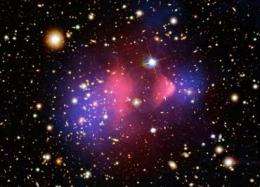Centuries-old math formula helps map galaxy clusters

(PhysOrg.com) -- Across the universe, galaxies band together in clusters so huge it can take 10 million years for light to travel from one end of a galaxy cluster to the other. Probing these metropolises is no easy task. But Assistant Professor of Astronomy Andisheh Mahdavi has found a centuries-old math formula that could help scientists map the shape and size of galaxy clusters.
Most galaxies congregate in groups of anywhere from a few to several thousand galaxies held together with extremely hot gas and a material thought to be mysterious dark matter. Galaxy clusters intrigue scientists because they hold clues about the nature of dark matter, the material that is believed to hold galaxy clusters together.
Galaxy clusters are the most massive structures in the universe and also the most recently formed structures in the universe. Researchers use them to explore how galaxies evolve and how galaxy clusters collide.
"When you look at a galaxy cluster in the sky, you see it like a painting," Mahdavi said. "What you don't know is how far the cluster extends away from you. This is a big problem for astronomers."
Powerful telescopes can observe galaxy clusters but they can't tell us how the deep a cluster extends along the line of sight. Mahdavi and his student Weihan Chang recenlty published a paper in The Astrophysical Journal Letters, proposing a new approach to the problem.
"We have figured out a new use for a centuries-old math theorem called the Cauchy-Schwarz integral inequality," Mahdavi said. "Scientists can plug their data from telescope observations into this formula and can use it to calculate the minimum depth of a galaxy cluster along the line of sight."
To date, the only mathematical models for this purpose required scientists to make assumptions about the shape of a galaxy cluster, often explicitly requiring it to have an egg or a ball shape.
But such assumptions are frequently incorrect given the irregularity of the shapes of galaxy clusters. "Often when you look at a galaxy cluster, it looks like an amoeba and that's even when you can't see the third dimension," Mahdavi said. "Sometimes two clusters have just smashed into each other and it just looks like a cosmic train wreck."
Mahdavi believes the formula will help scientists determine the geometry of galaxy clusters, which will ultimately strengthen research on dark matter and improve computer simulations of galaxy cluster collisions.
Mahdavi tested the Cauchy-Schwarz theorem using telescope observations of the Bullet Cluster, a galaxy cluster that is well known for containing the best evidence to date for the existence of dark matter. He will also use the theorem to continue his research on Abell 520, a galaxy cluster that is thought to be the result of a collision between three galaxy clusters.
The paper, published in The Astrophysical Journal Letters, can be found online at iopscience.iop.org/2041-8205/735/1/L4
Provided by San Francisco State University


















